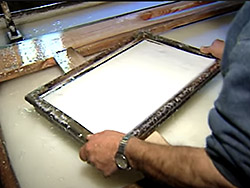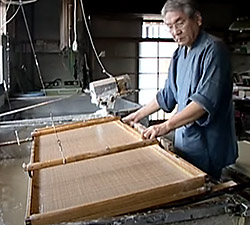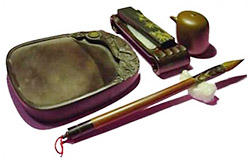Paper
This chapter covers the invention of paper in China and its gradual spread as it replaces earlier media, till it is widely adopted from Asia to Europe. Although paper making began in China about 2 thousand years ago paper mills didn't open in Europe until a thousand years later. It was a necessary development that made moveable type printing possible.
TOPICS
• The spread of paper: The earliest paper
• Paper making: Making paper by hand
• Making pulp manually
• Ink and calligraphy
• Pulp machines
• The paper industry
• Books
• Paper’s impact on the world
• Spread of paper map/timeline
• Paper making graphics - 4 panels
• Manual pulp making graphic
• Carbon burner illustration
• Ink sticks, stone, brushes illustration
• Pulp stamper illustration - 2 panels
• Hollander beater illustration - 2 panels
• Book making - paper folds graphic
• Book making - binding graphic
• Oldest paper
• Wang Xianzhi calligraphy example
• The Little Book of Trades woodcut - papermaking illustration
The date traditionally assigned to the invention of paper is 105 CE, and is credited to Ts’ai (or Cai) Lun, a court official in the Eastern Han dynasty of China. However, several paper fragments predating this time have been discovered, the oldest dating to as early as 179 BCE, so it’s unknown when paper was first made.
The problem with making paper is not so much technical—it’s a fairly simple process—as the amount of effort involved. In this way it was similar to papyrus or vellum, both of which required considerable time and labor to produce, making each sheet precious. For paper, the biggest problem is preparation: It’s made from the fibers of cellulose plant material, and requires a method of shredding the material and separating the individual fibers, which is labor and time intensive.
Also, the problem is cost of materials. The earliest paper fragments were made from expensive materials such as silk. It’s likely that what Ts’ai Lun is credited with was a practical and economical method of making paper from cost-effective materials such as common vegetation and old rags.
Paper was first adopted for a number of uses besides writing, particularly as wrapping material and padding. Its use as toilet paper began in the 6th century CE, and as teabags in the 7th. Paper money was first printed in China in the 10th century during the Tang dynasty.
But its use as writing material also spread rapidly as it replaced bound bundles of bamboo slips, which were bulky and heavy. Books could now be contained in a single scroll, easily hand carried (the slip bundles for even a single book required a cart).
The result was an increase in the spread of literature and of literacy in Chinese society, with many more individuals owning copies of books. By the 4th century CE, Chinese library collections were several times larger than those in Europe.
Paper
Papermaking: The History and Technique of an Ancient Craft. Dard Hunter, Dover Publications, 1943. Reprinted 1978.
Paper: Paging Through History. Mark Kurlansky, W. W. Norton & Company, New York, London, 2016.
European Papermaking Techniques 1300-1800. Paper through Time: Nondestructive Analysis of 14th- through 19th-Century Papers. T. Barrett, The University of Iowa 2012.
Early European Papers / Contemporary Conservation Papers. Timothy Barrett, The Paper Conservator 13 Part I, 7–27, 1989. European Papermaking Techniques 1300–1800.
The Dictionary of Paper, including pulp, paperboard, paper properties and related papermaking terms, 3rd ed. American Paper and Pulp Association 1965.
A Brief History of Paper. Fuller, Neathery Batsell. STLCC.edu, 2002.
The Lost Language of Symbolism. Harold Bayley, Citadel Press 1909 (1970).
The Story of Papermaking. Edwin Stutermeister, R.R. Bowker Company 1954.
Who was the Inventor of Rag-paper? A. F. Rudolf Hoernle, Journal of the Royal Asiatic Society of Great Britain and Ireland Art. XXII, p. 663, 1903.
A chronology of paper and papermaking. Joel Munsell, Albany, J. Munsell 1864.
Paper Basics: Forestry, Manufacture, Selection, Purchasing, Mathematics and Metrics, Recycling. David Saltman, Van Nastrand Reinhold Company 1978.
Papermaking. Ralf Weidenmüller, John Kalish translator. Thorfinn International Marketing Consultants Inc. San Diego and Ralf E. Soderholm, London 1980.
The Manufacture of Paper: Being a Description of the Various Processes for the Fabrication, Coloring, and Finishing of every Kind of Paper. Charles Thomas Davis, Arno Press 1886 reprinted 1972.
Ink on Paper, A Handbook of the Graphic Arts. Edmund C. Arnold, Harper & Row 1963.
Papermaking: The Historical Diffusion of an Ancient Technique. Jonathan M. Bloom, Springer 2017.
Four Treasures of the Study. "Four Treasures of the Study (文房四宝 wén fáng sì bǎo) is an expression used to refer to the ink brush, inkstick, paper and inkstone used in Chinese calligraphy and painting" chinaonlinemuseum.com.
Sizing Agents. pulppapermill.com.
A Brief History Of Paper. St. Louis Community College, July 2002.
Paper Mill of Vaux and Forges of Savignac-Lédrier. Château le Verdoyer, June 22, 2016.
Early paper
Envisaging the City. David Buisseret, U. of Chicago Press 1998, p. 12.
Introduction : Pre-Gutenberg Printing. The Shoyen Collection, London and Oslo.
Missal of Silos. wikipedia.org.
Water wheel
Denis Diderot’s Encyclopedie, 1767.
Denis Diderot. Stanford Encyclopedia of Philosophy, June 19, 2019.
Denis Diderot’s Encyclopedia, or a Systematic Dictionary of the Sciences, Arts, and Crafts. Harald Sack, SciHi Blog, July 31, 2018.
The History of the Water Wheel. Mary Bellis, ThoughtCo., Nov. 24, 2019.
Water Wheel History. Top-Alternative-Energy-Sources.com, 2008.
Water Wheels. Roger D. Hansen, waterhistory.org.
List of ancient watermills. wikipedia.org.
China exploration
Ancient Chinese Explorers. Evan Hadingham, Nova, PBS, Jan. 15, 2001.
Block books
The Quincentennnial of Netherlandish Blockbooks. Allan H. Stevenson, British Museum Quarterly, Vol. 31, No. 3/4 Spring 1967.
NOTE: Weblinks were current and active at the time of the last update to the site, but may have since become unavailable or outdated. If you encounter a dead link, please notify me at phil.loubere@mtsu.edu. Thanks.
Last update: April 2021
Content related to this chapter’s topics will be periodically posted here.
Paper making

Papermaking: The History and Technique of an Ancient Craft. Dard Hunter, Dover Publications, 1943. Reprinted 1978.
The most commonly cited text on the history of paper is Dard Hunter’s 'Papermaking: The History and Technique of an Ancient Craft'. First published in 1943, it is the most complete account of the origins and practices of paper making around the World, and Mr. Hunter is often cited as the preeminent authority on the topic of paper. It is also entertaining reading, as Mr. Hunter employed an elegant and entertaining writing style.

Traditional Paper Making Process. 601ProductionLTD, youtube, May 25, 2012.
This video shows the entire papermaking process as it was practiced in pre-industrial times. It shows a water wheel stamper in operation.

Sekishu-Banshi: papermaking in the Iwami region of Shimane Prefecture. UNESCO, youtube, Sept. 26, 2009.
This video shows a very work-intensive process from producing pulp to finished sheets as it is practiced in traditional Japanese paper making.
Calligraphy

Four Treasures of the Study. chinaonlinemuseum.com.
The four treasures are the ink brush, inkstick, paper and inkstone used in Chinese calligraphy and painting.
Last update: July 2021


